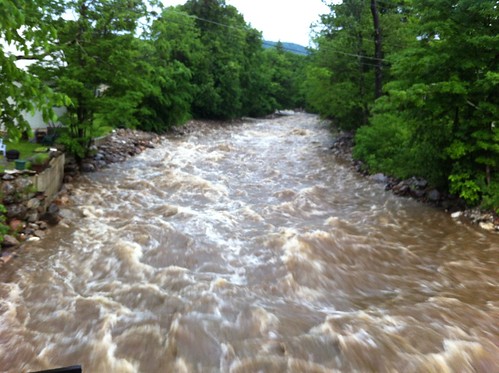
Torrential rains - probably up to 4 inches in places, fell in just a few hours, accompanied by incredible lightning. The river quickly rose, and the small bit of earth keeping the river from shifting course quickly was washed away. The oxbow I've been watching for nine months has now cut.
The long weekend was a warm one, with little or no rain, despite warnings of possible severe storms on Monday. The river had dropped quite a bit - on Monday, for the first time since last summer, the weather was warm enough and the water level low enough that I could easily wade across the river in most places. The day was hot, and mostly still. There were signs of a change in the air, however.

These clouds were Altocumulus castellanus clouds, which indicate that there is a lot of energy and instability in the middle layers of the troposphere. At the time of the photo, there were no thunderstorms anywhere near East Middlebury, as evident on the radar. By midnight, however, I was awakened by rain and thunder, and upon looking out the window I was greeted with multiple flashes of sheet lightning. The first wave of the storm had began.
These storms passed quickly, but by daybreak another wave was moving into the area. This one was stronger, dousing the area between Bristol and East Middlebury with heavy rain and slamming the sides of the Green Mountains with cloud to ground lightning.
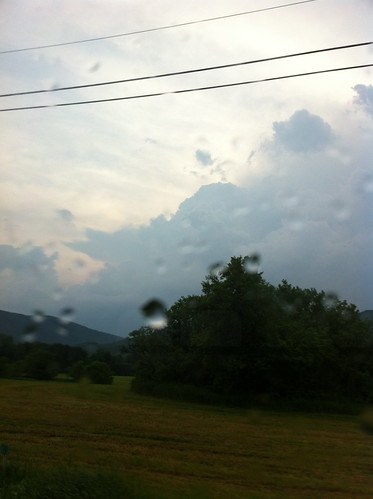
Looking south, from Hinesberg (above), the storms were evident. There were also some moving out of Winooski, and in their wake were these mammatus clouds:

Mammatus cloud formations are often (but not always) associated with severe weather. Note also the odd colors in the cloud. Severe thunderstorms often are oddly colored, perhaps due to hail in the cloud. Tornadic thunderstorms are also often reported to be greenish or otherwise oddly colored.
At noon, I stepped outside. The sun was glaring down and the air was incredibly hot and muggy, and nearly still. The sun beat down on the ground, creating instability that set off the third and final round of storms. These also proved to be the most violent. Numerous severe thunderstorm warnings and even tornado warnings were issued as the storms moved through Vermont. I'm not sure if any tornados touched down, but reports of damage from wind and large hail were widespread.

Later in the afternoon, a storm stalled over East Middlebury. I wasn't here, but the rain was apparently torrential - perhaps up to 4 inches fell just that afternoon. Not surprisingly, the Middlebury River quickly rose, and was near peak by the time I got home.
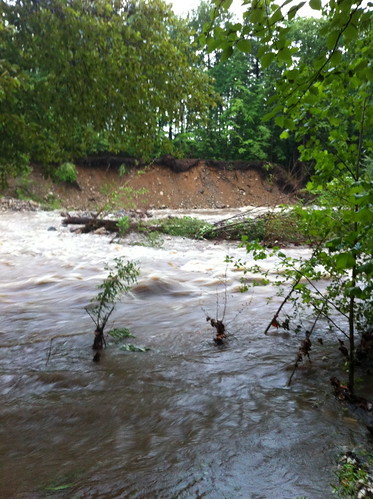
I chose not to try to approach the oxbow cut area during the flood, because I realized a lot of trees would probably be knocked over when the river shifted. This morning I ran out to the river and briefly visited the oxbow site, and I came back this evening. The result was quite impressive.

The river seemed to be vanishing into the woods.

To the left, the old riverbed was visible, but had dried to a trickle.
The river was raging right through the forest!
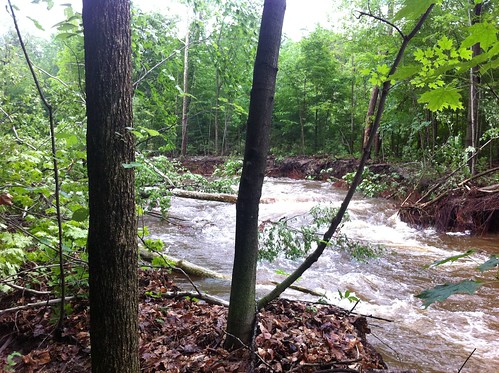
I tried to approach my photopoint where i'd been documenting the slow erosion of the oxbow cut, but it was effectively unrecognizable. Here's the closest approximation:
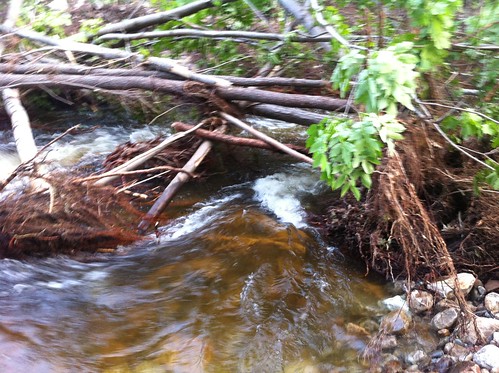
There had been no tornados in East Middlebury, but the forest looked like it had been hit by one. Trees were strewn everywhere!

The old path of the river is not yet accessible, because the river is too full to wade across. From what I could see it was almost dry, and flash flooding from above had collapsed some of the old riverbank:
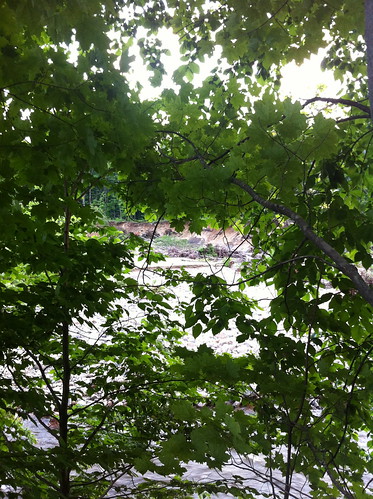
Downstream from the oxbow cut, the river doesn't look all that different from how it was before the cut happened. However, there is probably less water being forced towards the property to the north of the river now, which is a good thing.
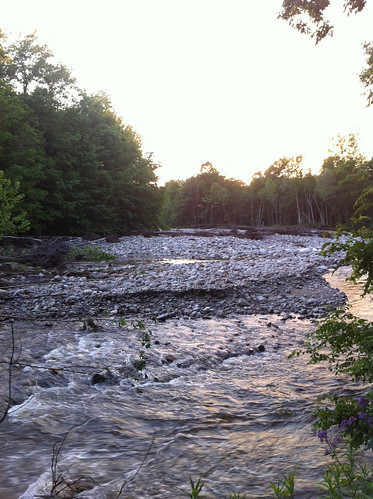
It was amazing being able to watch this natural process, and see the area just before and just after the cut happened. It's a good thing I didn't get near the river when it was first creating the cut, because a tree might have fallen on me.
The loss of the mature sycamores is sad, especially since they are uncommon here in Vermont, but in truth without such events sycamores wouldn't be here at all. These trees, like cottonwoods, establish almost exclusively in sand and gravel bars along rivers. Sycamores in Vermont, in particular, seem to only occur on cobble bars along fast-moving rivers. Now that the river has shifted, there is a large area of bare sand and cobble that is perfect for sycamore and cottonwood seedlings to establish. These trees seem to 'know' just when to release seeds - over the past few days the air has been full of fluffy cottonwood seeds. Undoubtedly a few cottonwood seeds landed in the exposed riverbed in the first hours after the river shifted, and in the next few weeks the first seedlings will be sprouting. These trees grow fast, and in two or three decades a lush cottonwood and sycamore forest will probably have established in the oxbow, with wetlands persisting in the immediate riverbed. Over the years sugar maples will also colonize the stabilized soil, and the forest will continue to grow until the next time the river shifts course and starts the process anew.
Cottonwoods and sycamores are able to use the natural shifting and flooding of rivers to their advantage, and colonize habitat with abundant nutrients and water before other trees get a chance. Unlike most humans, they not only tolerate, but actually take advantage of the river's floods. It is only through destruction like this oxbow cut that they are able to persist.
Click here for a radar animation of this sequence of storms.

No comments:
Post a Comment